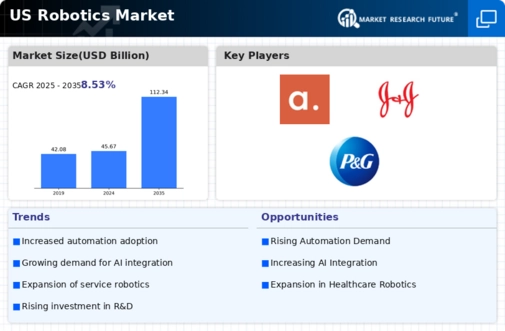Advancements in Robotics Technology
Technological advancements are playing a pivotal role in shaping the US Robotics Market. Innovations in sensors, machine learning, and artificial intelligence are enabling robots to perform complex tasks with greater accuracy and efficiency. For instance, the development of advanced robotic arms equipped with AI capabilities allows for enhanced dexterity and adaptability in various applications. The market for industrial robots is expected to grow at a compound annual growth rate of approximately 10% over the next five years. This growth is indicative of the increasing reliance on sophisticated robotic solutions across diverse sectors, including healthcare, logistics, and agriculture. As technology continues to evolve, the US Robotics Market is likely to witness a proliferation of new applications and use cases, further driving market expansion.
Expansion of Robotics in Healthcare
The healthcare sector is witnessing a remarkable expansion of robotics, significantly impacting the US Robotics Market. Robotic systems are increasingly utilized for surgical procedures, patient care, and rehabilitation, enhancing the quality of care and operational efficiency. The market for medical robots is projected to reach over 10 billion dollars by 2026, driven by the demand for minimally invasive surgeries and improved patient outcomes. Additionally, the integration of robotics in telemedicine and remote monitoring is gaining traction, particularly in response to the growing need for accessible healthcare solutions. This trend indicates a transformative shift in the healthcare landscape, positioning the US Robotics Market as a key player in the evolution of medical technology.
Increased Focus on Safety and Compliance
Safety and compliance are becoming increasingly paramount in the US Robotics Market. As robots are integrated into various work environments, ensuring the safety of human workers is essential. Regulatory bodies are establishing stringent guidelines to govern the use of robotics, particularly in sectors such as manufacturing and healthcare. Companies are investing in safety features and compliance measures to mitigate risks associated with robotic operations. This focus on safety is likely to drive the adoption of advanced safety technologies, such as collaborative robots designed to work alongside humans without compromising safety. Consequently, the US Robotics Market is expected to evolve in response to these regulatory demands, fostering a culture of safety and responsibility.
Rising Demand for Automation in Manufacturing
The US Robotics Market is experiencing a notable surge in demand for automation within the manufacturing sector. As companies strive to enhance productivity and reduce operational costs, the integration of robotic systems has become increasingly prevalent. According to recent data, the manufacturing sector is projected to invest over 20 billion dollars in robotics by 2026. This trend is driven by the need for precision, efficiency, and the ability to operate in hazardous environments. Furthermore, the adoption of robotics is not limited to large enterprises; small and medium-sized enterprises are also recognizing the benefits of automation. This shift towards automation is likely to reshape the landscape of the US Robotics Market, fostering innovation and creating new opportunities for growth.
Growing Investment in Research and Development
Investment in research and development is a critical driver of growth within the US Robotics Market. Companies are allocating substantial resources to innovate and improve robotic technologies, which is essential for maintaining competitive advantage. In 2025, it is estimated that R&D spending in the robotics sector will exceed 15 billion dollars, reflecting a commitment to advancing capabilities and exploring new applications. This investment not only fosters technological breakthroughs but also encourages collaboration between academia and industry, leading to the development of cutting-edge solutions. As a result, the US Robotics Market is likely to benefit from a continuous influx of innovative products and services, enhancing its overall competitiveness and sustainability.

















Leave a Comment